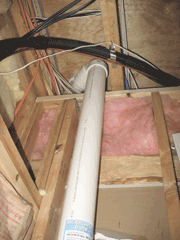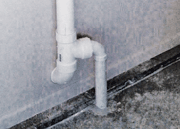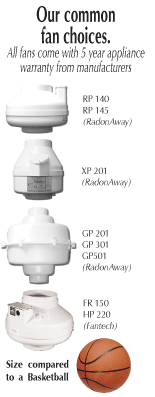BEST PRACTICES
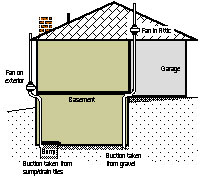
|
COSMETICS
SUMPS
EFFECTIVENESS
SEALING
ELECTRICITY
RETESTS AND GUARANTEES
INSURANCE
PIPE RUNS
NOISE
DISCHARGE
FANS
ENERGY EFFICIENCY
STANDARDS
ACTION LEVELS: 4.0, 2.7, 2.0 pCi/L |
COSMETICS
Even the most simple system is a custom design.
There are almost always several options.
To the extent practical, maintain the cosmetic integrity of the home.
Poor cosmetics can affect the value of the home.
|
|
SUMPS
A flooding basement is an urgent event.
RESPONSIBLE SUMP COVERS
• Visual access to conditions in pit
• Removable plug for arm access
• Anchored and sealed air tight
• Labeled
• Can hold the weight of an adult
SUMP SUCTION? Best avoided.
Obstructs access to pump for repair or emergencies.
Sump Suction may be an important option for homes built before the 1960s in our area with slabs poured directly onto soil or homes built with sand or compacted soil under the slab.
NOTE: Rubber coupling REQUIRED on the suction pipe to provide at least some easier acess for removing cover.
Obstructed access to pump for repair or emergencies. |
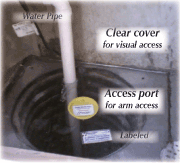
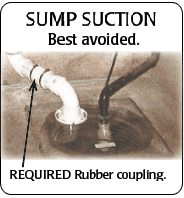
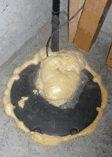
|
EFFECTIVENESS
ADDRESSING THE WHOLE BUILDING: Radon enters from under all areas (including from under the garage) with potency usually based upon area size.
When practical, seeking 100% control of the home's footprint for soil contact will serve to maximize reductions.
The degree of reductions needed and practical considerations such as pipe in finished areas will dictate choices. Still, maximium reductions are achieved with 100% control of the home's footprint.
EFFECTIVE SUCTION PIPE LOCATIONS FOR GRAVEL: Effective locations can be anywhere in the slab. Since it is hollow underneath, location does not matter.
EFFECTIVE SUCTION PIPE LOCATIONS FOR SOIL, SAND, CLAY: Extension of sub-slab vacuum is more of a challenge. Hollow gaps near the edge, locations that might best achieve exterior draintile vacuum extension or sumps with draintile extensions.
CRAWL SPACES - SUBMEMBRANE DEPRESSURIZATION: Suction to under plastic sheeting. Poly sheeting placed over open earth and secured/sealed to walls. |
CLICK TO SEE PHOTOS
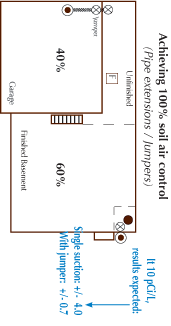

|
SEALING
A mostly closed barrier between soil and living spaces is important for establishing a slight vacuum under the home.
However, a substantial leakage area will always exist undetectable to the eye regardless of meticulous efforts.
Fortunately system effectiveness does not depend upon a complete seal because systems pull soil air away from living spaces. Pragmatic choices regarding the situation and extent of sealing truly needded are therefore wise.
Since leakage across the slab will always exist, “EPA does not recommend the use of sealing alone to reduce radon because, by itself, sealing has not been shown to lower radon levels significantly or consistently.”
|
|
ELECTRICITY
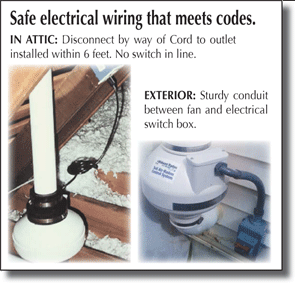
Concerns:
• On a switched circuit?
• Cords run through walls or on exterior?
• Exterior wire not be protected by sturdy conduit?
• No disconnect (plug or switch) within eyesight of the fan?
|
|
RETESTS AND GUARANTEES
A PORTION OF THE SYSTEM COST RELATES TO VERIFICATION OF SUCCESSFUL REDUCTIONS.
About 1 in 15 systems require adjustment to achieve or maintain desired success.
A wide range of different guarantees are provided by different contractors.
Guarantees should cover any retest by any owner (with an ample years under warranty to test and verify continued effectiveness).
Retest quickly after installation with a continuous monitor where hourly readings can help identify problems and verify success.
Retest independently in the near future.
How attractive prices earn added contractor profit by avoiding service?:
1) Not specifying guarantee or tying warranties to complicated procedures of testing, registration, etc.
2) Disclaiming common workmanship issues (i.e. sumps).
3) Delaying retests, testing without hourly readings (so that problems are obscured) or only leaving test kits knowing that clients will often forget to perform the retest.
|
RETEST: After installation, insure a retest with a continuous monitor is performed where hourly readings can help identify problems.
Thereafter: You may test for verification at any time. The USEPA recommends retesting every two years to insure continued effectiveness. Home test kits are an inexpensive and effective test for this purpose.
 |
INSURANCE
Worker Compensation • Business Auto • Professional Liability
Worker injuries and damage to should not unknowingly be the responsibilities of homeowners or their agents.
|
"No frills" price may often mean skipping the overhead of buying full insurance. |
PIPE RUNS
PIPE SIZE: The piping must be capable of moving the needed volume of air to establish a vacuum under the home. Typically, 3 inch piping moves enough air for most homes yet some require 4" piping. 2" piping has been often seen to not allow enough air volume to address most homes.
MUST DRAIN: Pipes must be able to drain water (from significant condensation within piping and other sources).
Long horizontal runs should be minimized, when practical. Building settlement and other factors can cause stress on joints or strapping and result in water leaks or changes in pipe pitch needed for draining water.
PRESSURED SIDE PIPE: All components after the fan must be outside of heated and cooled spaces. Pressure side piping blows air out and any leak or break in piping can introduce potent radon into the home.
PIPES THROUGH WALLS AND CEILINGS: Pipes can routinely pass through joists, finished walls and ceilings with tight hole fitting to allow reasonable cosmetics. Concerns only relate when a pipe might compormize the structural integrity of a joist or other component. |
|
NOISE
Fan and piping must be routed to not touch wood framing in a fashion to minimize transfer of vibrations to wood framing. It is seldom the fan that causes noise unless failing. |
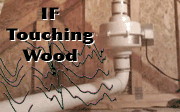 |
DISCHARGE
OPEN - BLOWING FREELY AWAY FROM THE HOME - NO RAIN CAPS:
LOCATIONS: High on the home (or at least 10 feet above grade). Requirements resemble those for sewer gas or chimney vents to help assure polutants do not enter the home through windows or other openings into living space. Discharge must be at least 2 feet above or 10 feet to the side of any operable window or opening into occupied spaces of the home.
|
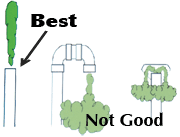 |
FANS
Choices: Experience in choosing the best fan is important. It is a balance between vacuum pressure needed (based upon sub-slab conditions) and air volume needed (based upon cavity sizes and tightness.
Bigger is not better yet too small will result in compromised effectiveness in cold weather. Oversized fans can cause noise, excess energy loss and problems with other building systems such as combustion appliances. Light duty fans require situations where all gaps and openings to soil can be sealed.
For older homes or any built upon tight soil or sand, high suction fans may be required and are capable of greater vibration. Choosing a smart location for the fan becomes important.
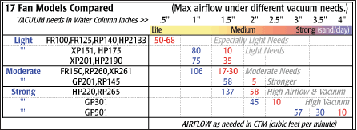
|
|
ENERGY EFFICIENCY
Continuous operation is required yet inexpensive (similar to a 40-80 watt light bulb).
There is a also minor energy penalty when air is pulled out of the home but major renovations to seal small cracks are not justified monetarily. Homes with mostly closed slabs and easy airflow under the home will be least subject to energy loss.
Maximized energy efficiency requires two components that must already exist for the home: 1) Easy airflow under the home, and 2) The ability to tightly seal the cavity under the home. |
|
STANDARDS
Systems must comply with national standards: EPA-RMS (1994), AARST ASD-RMS (2006) and/or ASTM E2121 (2001-2008).
These standards lay out requirements for locations of discharge and fans while also covering details of pipe runs, sealing and more. |
EPA
AARST
ASTM |
ACTION LEVELS: 4.0, 2.7, 2.0 pCi.L
4.0 pCi/L Achieving below the USEPA action level of 4.0 pCi/L can be accomplished for virtually any home. Older homes can present challenges due to construction practices when they were built and in special cases it can become a question of expense versus benefit.
2.7 pCi/L The World Health Organization (WHO) has recently modified their recommended action level from about 5.3 pCi/L to about 2.7 pCi/L. This reflects recommendations regarding life-long, direct exposure. The change reflects recent population studies for statistical evidence of radon induced lung cancer.
2.0 pCi/L The USEPA recommends to consider action between 2 and 4 pCi/L since no exposure is safe. However, around about 2.0 pCi/L and lower, the lower limits of sensitivity for test devices has been reached and errors up to 300% have been seen to occur. Hence, verifying less than 2.0 pCi/L is not truly feasible (though some contractors knowingly or unknowingly make such claims or warranties).
0.7 pCi/L Outside air anywhere on earth. This is so low that even the best equipment scientists use can only estimate between 0.4 to 0.8 pCi/L. |
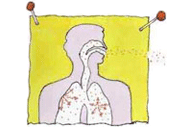 |
 |










